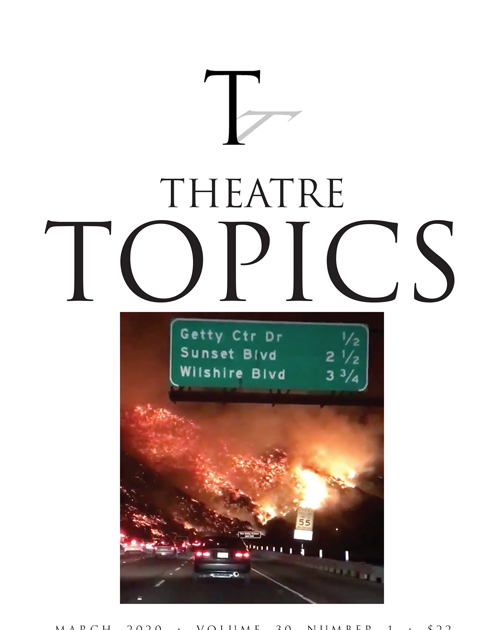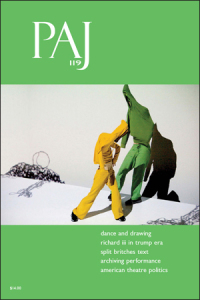Thinking through Theatre and Performance by Maaike Bleeker, et al. (review)
Theatre Topics, 30.1
 Opening section
Opening section
What can theatre help us to do? How can performance help us to think in new ways? What are the possibilities that theatre can open up? What can we learn from the performing body? How might theatre function as theory? Thinking Through Theatre and Performance, the first in an announced series of books called “Thinking Through Theatre,” offers twenty-one essays that provide answers, propositions, and provocations in response to these and other queries. The book is edited by Maaike Bleeker, Adrian Kear, Joe Kelleher, and Heike Roms, and it boasts an impressive array of international Anglophone scholars who address a range of questions that are important for any student of theatre and theatre-making practice.
At first glance, the queries that serve as title chapters in Thinking Through Theatre and Performance—for example, “Why Study Drama?” (chapter 1), “What Do Performances Do to Spectators?” (chapter 2), “How Can Performance Disrupt Institutional Spaces?” (chapter 17)—might seem as though they are introductory questions aimed at first-year undergraduates or students only just embarking on a study of theatre and performance. Each essay, however, interrogates its central question so deeply and with such rich results, that the questions feel as though they are asked anew. This is not an Introduction to Theatre textbook; these are inquiries intended for those of us who have been studying theatre already for some time. Better yet, the questions in this book ask us to look again at problems that seem basic to making performance, at assumptions we might have held for a long while, and at ideas we take for granted. The answers are inspiring, designed to push theatre artists in new directions and open up new ways of thinking for artists engaging with politics (chapter 15), accessibility (chapter 3), labor (chapter 11), and many other ideas. Thinking Through Theatre and Performance, then, is a book for upper-level undergraduates, graduate students—especially those in MFA programs—and theatre companies and artists as they make new work. The book operates at a sophisticated level of discourse, and the essays ask and attempt to answer difficult questions related to making and performing theatre.
Microdramas: Crucibles for Theater and Time by John H. Muse (review)
PAJ: Performing Arts Journal, 40.2
 Opening section
Opening section
It seems appropriate that in our current moment – as we scroll through Instagram or watch brief videos on Snapchat – that a theatre scholar would seek meaning and profundity in short plays. After all, people’s attention spans are reportedly growing shorter and shorter, and more and more theatre syllabi are assigning one-act plays as a way to keep students interested in the material. But John H. Muse argues that shortness has felt modern since at least the late nineteenth century, that increasingly brief time spans have long seemed, to artists and audiences both, to reflect the pace of modern life. Muse’s Microdramas has a simple thesis: Short plays, despite their brevity, perhaps even because of it, deserve close attention. The argument is straightforward, but Muse’s book, like the plays and performances he explores in such detail, is filled with surprising insights.
Muse begins by exploring the modernist interest in short theatrical events. Theatre practitioners in the Naturalist, Symbolist, and Futurist movements all, for various reasons, turned their attention to shortened drama. Although these modernist movements are often understood in opposition to one another, Muse argues that their use of the short play for their experiments produced pieces with strikingly similar dramaturgies and characters. One of the key early insights of Microdramas is that the very medium of theatre gives weight to what it represents; as Muse puts it, “theatrical attention makes matter matter.”
Making the Radical Palatable by Jacob Juntunen (review)
New Theatre Quarterly, 33.2
Opening section
The argument of Jacob Juntunen’s Making the Radical Palatable is simple: that mainstream AIDS theatre—unlike the radical performances described by David Román in Acts of Intervention—was able to effect incremental change in the U.S. by diluting the radical politics of AIDS activism and aiming for ‘assimilation’ instead of a ‘restructuring of society’. Juntunen’s book recognizes the limitations of assimilationist projects, and he spends a good deal of time critiquing the flaws in the plays he studies, but Juntunen is invested, finally, in the idea that these theatre pieces actually changed the U.S. imagined community through modest goals and palatable politics.
The bulk of Making the Radical Palatable is four case studies, each on a different play about HIV+ gay men. Each piece will be instantly recognizable to readers—The Normal Heart (1985), Angels in America (1992), Rent (1996), The Laramie Project (2000)—and their familiarity and popularity make the book’s claims appear self-evident...
Crossing (performance review)
Theatre Journal, 68.1
Opening section
Two days before the new opera Crossing had its first performance at the Citi Shubert theatre in Boston, The New York Times published a piece entitled “Matthew Aucoin, Opera’s Great 25-Year-Old Hope.” The article, which introduced Crossing’s composer to Times readers, emphasized Aucoin’s abilities as a musician, conductor, and composer, but it stressed above all Aucoin’s age. Crossing’s audience was abuzz with talk of this Times article, and a sense of youthful audacity, the feeling that we were witnessing something novel – even rebellious – pervaded the performance of Crossing. The new opera, with music and libretto by Aucoin, is a musical inquiry into the legacy of the American poet Walt Whitman; its subject matter is concerned also with temporalities, the distance between the past and the present, and the relevance of Whitman to generations that followed him. Because Crossing was also a part of the American Repertory Theater’s contribution to the National Civil War Project, a multi-year, multi-city collaboration between theatres across the country that commemorated the 150th anniversary of the U.S. Civil War, the opera also attempts to situate the ongoing effects of that conflict in our lives.
Crossing addresses precisely this distance, opening with Walt Whitman (Rod Gilfry) singing directly to the Bostonian audience in his beautiful Baritone; “What is it, then, between us?” In this way, Aucoin’s libretto firmly situates Whitman in his own time period and performs the evening’s first crossing – a query about both the relationship between audience and poet as well as the relationship between the present-day United States and our complex, war-torn past. Based on diaries that Whitman kept at a Union hospital near the end of the war, Crossing finds the poet nursing and caring for wounded soldiers in a forgotten building that might be The soldiers have lost hope, but Whitman provides what care he can: listening to the men, encouraging them, writing their letters.
Murder Most Queer by Jordan Schildcrout (review)
Journal of Dramatic Theory and Criticism, 29.2
Opening section
At the outset of Murder Most Queer, Jordan Schildcrout notes the prevalence of the criminalized, murderous, queer villain in our contemporary media. From the atrocities of Jeffrey Dahmer to the crimes passionels of Andrew Cunanan to the so-called man-hating, lesbian serial killer Aileen Wournos, newsmedia have obsessed over—and in some cases exaggerated—gay and lesbian murderers and their crimes. Schildcrout begins with these sensationalized real-life queer killers as a way of describing how the image of the homicidal homosexual has been appropriated and mobilized within mainstream culture as both a symbol for the culture’s strongest taboos—against violence and deviant sex—and as a justification for real-world violence against queer bodies. But, as Schildcrout aptly puts it, “Hollywood cinema is not the only cultural venue, and this particular scenario for the homicidal homosexual is not the only script” (3). Murder Most Queer is not a book about the queer killers that television newsmedia and big-studio movies show us but about ways that playwrights and theatre audiences have defended and castigated, loved and reviled, and identified and disidentified with the homicidal homosexual onstage in the United States. It is Schildcrout’s contention that representations of queer killers have a great deal to teach us about ourselves as audience members, both straight and queer. Although he very wisely avoids making arguments about which representations are “good for the gays” or “bad for the gays” (10), as an organization such as the Gay and Lesbian Alliance Against Defamation might do, he argues “that plays with homicidal homosexuals should not be dismissed simply as negative representations, and even plays that may be homophobic demand closer analysis for the ways in which they construct queer villainy” (15). Schildcrout offers many—often resistant—readings that counter constructions of the queer as villain, demonstrating just how intriguing a fictional queer murderer can be.
The Grapes of Wrath (performance review)
Theatre Journal, 66.4
Opening section
The Grapes of Wrath begins without music. John Steinbeck began his 1939 novel by describing the formation of clouds of dust as they rose out of the dry, broken land in Oklahoma. The empty silences are almost palpable in the novel as the winds pick up, the skies darken, the sun goes red, and the farmers stand staring at the land, trying to figure what they are going to do next. In a way, however, both the novel and Frank Galati’s stage adaptation begin with music after all. For his book about workers traveling west, Steinbeck chose as his title a lyric from Julia Ward Howe’s “Battle Hymn of the Republic,” written in 1861. “Mine eyes have seen the glory of the coming of the Lord,” the song begins. “He is trampling out the vintage where the grapes of wrath are stored.” Steinbeck expected a majority of his readers to know the song, and it was printed in the book’s first edition. The form of the song, like the form of the novel, is a march: a protracted journey across a country filled with laborers who cannot find work. Far from Route 66 and seventy-five years after the novel’s first printing, the Asolo Repertory Theatre could no longer assume that audiences would know this music, but their adaptation is nonetheless a Grapes for our own time. The show started abruptly with the terrifying sound of a crash, one that continued for too long—so long, that defining the sound became impossible. Something was being crushed or uprooted, or perhaps something was being pushed off its foundation. The play began with this unsettling sound, but it was otherwise filled with the music of the 1930s: classic folksongs from the period divided up the play’s sequences and provided intermittent visions of utopian possibility amid the dry misery of the play’s setting.
Speaking about Torture by Julie A. Carlson and Elisabeth Weber (review)
Journal of Dramatic Theory and Criticism, 28.1
Opening section
In an environment in which the humanities have more and more often been asked to prove their worth and to demonstrate their efficacy vis-à-vis problems in the material world, the editors of Speaking about Torture ask: In what ways might disciplines within the humanities address the torture policies of the twenty-first century? Speaking about Torture as a whole provisionally answers that question, with a range of chapters covering diverse fields in the humanities. These include essays on the use of music as a modern torture technique, analyses of poetry about Abu Ghraib, criticism of the treatment of the Guantánamo Bay detention center in painting, and close-readings of now-classic texts on torture such as Jean Améry’s At the Mind’s Limits and Elaine Scarry’s The Body in Pain, as well as essays that discuss torture in relation to Egyptian film, pornographic literature, and university ethics.
Twenty-First-Century Play, Nineteenth-Century Scripts (review)
Cultural Studies, 26.6
Opening section
After James Kincaid’s Erotic Innocence (1998), Lee Edelman’s No Future (2004), and Kathryn Bond Stockton’s Growing Sideways (2009), it would seem that the critical study of literature about children as cultural agents – and of childhood itself as an important cultural designation – have truly become topics worthy of widespread consideration. Robin Bernstein’s Racial Innocence contributes to this growing area of study in unique ways by addressing the racialisation of childhood and by focusing in particular on dolls and doll culture. Racial Innocence describes the ideological project through which racially saturated doll-play is coded as innocent – as though it were race-less – because of its connection to childhood. In this way, Bernstein’s work emphasises the centrality of girls and girlhood to U.S. culture as a whole.
Sweet Tea: Black Gay Men of the South by E. Patrick Johnson (review)
Gay and Lesbian Review Worldwide, 16.2
Opening Section
Thirteen years in the making, E. Patrick Johnson’s new book Sweet Tea is a wealth of information about Southern black gay men and a valuable addition to gay cultural history. Sweet Tea is an oral history, or rather a series of oral histories. The book is divided into seven sections—growing up, coming out, the church, “homosex,” “trannies,” love and relationships, and the generation gap. Johnson further divides these sections by interviewee: that is, the opinions of the men in Sweet Tea are not compiled and summarized by the book’s author. The men of Sweet Tea speak for themselves.







